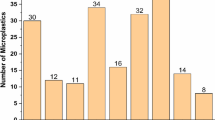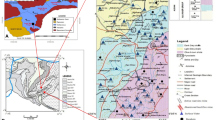Abstract
The Lead–Zinc Company region, Kardjali city, Bulgaria, is known to be highly polluted with heavy metals from its pyrometallurgical activities. The polluted levels and the chemical speciation in surface natural waters in the region as well as in the wastewaters of the factory were investigated in January 2008 by application of monitoring studies, thermodynamic modeling, and interpretation in terms of the “softness–hardness” factor. It was found that the levels of trace metals pollution of surface waters were lower than the legislation limits for the regions with Pb and Zn production. The wastewater treatment facilities of the company were found to operate properly, and the quality of the cleaned waters in station Kar4 was comparable to the other surface waters studied (e.g., station Kar5). The trace metals were divided into three groups: (1) Fe3 + and Al3 + , being “hard” acids, existed in all the studied waters as hydroxy species Fe(OH)\(_{2}^{+}\), AlOH2 + , and Al(OH)\(_{2}^{+}\), followed by the phosphate species AlPO\(_{4}^{0}\) and Al2(OH)2PO\(_{4}^{+}\); (2) Mn2 + , Zn2 + , and Cd2 + being “soft” acids with crystal field stabilization energy (CFSE) = 0 were present in natural waters mainly as free Me2 + ions. Small concentrations of their MeSO\(_{4}^{0}\), MeCO\(_{3}^{0}\) species, and of MeCl\(_{2}^{0}\) (Me = Zn, Cd) species were also calculated. In the wastewaters, two more species [Me(SO\(_{4})_{2}^{2-}\) and Me(SO\(_{4})_{3}^{4-}\)] of the softer Zn and Cd metals were also calculated; (3) Cu2 + and Pb2 + , as “soft” acids with CFSE \(\ne \) 0 preferentially coordinated with softer CO\(_{3}^{2-}\) ions and in natural waters existed mainly as MeCO\(_{3}^{0}\) and PbHCO\(_{3}^{+}\), followed by free Me2 + ions and MeOH + . In the wastewaters, MeSO\(_{4}^{0}\) and Pb(SO\(_{4})_{2}^{2-}\) species increased at the expense of the free Me2 + ions. The highest self-cleaning capability of natural waters was found with respect to Al and Fe, followed by Mn and Cd. The lowest corresponded to Pb, Cu, and Zn.
Similar content being viewed by others
References
Allison, J. A., Brown, D. S., & Novo-Gradac, K. J. (1991). MINTEQA2/PRODEFA2, A geochemical assessment model for environmental systems: Version 3.0 user’s manual (p. 106). US Environ. Prot. Agency, EPA/600/3-91/021.
Andres, N. F., & Francisco, M. S. (2008). Effects of sewage sludge application on heavy metal leaching from mine tailings impoundments. Bioresource Technology, 99(16), 7521–7530.
Banks, D., Younger, P. L., Arnesen, R.-T., Iversen, E. R., & Banks, S. B. (1997). Mine-water chemistry: The good, the bad and the ugly. Environmental Geology, 32(3), 157–174.
Desbarats, A. J., & Dirom, G. C. (2007). Temporal variations in the chemistry of circum-neutral drainage from the 10-Level portal, Myra Mine, Vancouver Island, British Columbia. Applied Geochemistry, 22, 415–435.
ECEL (1998). European community environmental legislation. Directive 98/83/EC on the quality of water intended for human consumption.
ECEL (2006). European community environmental legislation. Directive 2006/44/EC on the quality of fresh waters needing protection or improvement in order to support fish life.
Grenthe, I., Plyasunov, A. V., & Spaniu, K. (1997). Estimations of medium effects on thermodynamic data. Chapter IX, Modelling in aquatic chemistry (pp. 325–426). Paris: OECD.
Klopman, G. (1968). Chemical reactivity and the concept of charge- and frontier-controlled reactions. Journal of the American Chemical Society, 90, 223–234.
LZC, Lead and Zinc Complex Plc, Kardjali, Bulgaria. http://www.ock-bg.com/.
Marani, D., Macchi, G., & Pagano, M. (1995). Lead precipitation in the presence of sulphate and carbonate: Testing of thermodynamic predictions. Water Research, 29(4), 1085–1092.
Parkhurst, D. L. (1995). User’s guide to PHREEQC—a computer program for speciation, reaction-path, advective-transport, and inverse geochemical calculations. US Geological Survey Water-Resources Investigations Report 95-4227, 143.
Pearson, R. (1962). Hard and soft acids and bases. Journal of the American Chemical Society, 85, 3533–3539.
Rabadjieva, D., Tepavitcharova, S., Todorov, T., Dassenakis, M., Paraskevopoulou, V., & Petrov, M. (2009). Thermodynamic modeling of inorganic chemical speciation in river waters affected by mine water discharges. Euro-Asian Journal of Sustainable Energy Development Policy, 3 (in press).
Salomons, W. (1995). Environmental impact of metals derived from mining activities: Processes, predictions, prevention. Journal of Geochemical Exploration, 52, 5–23.
Tsvetkov, S. (2002). Observation and study of pollution in the region of the “Lead–Zinc Factory”—Kardzali. Annual of the University of Mining and Geology “St. Ivan Rilski”, 44–45, II, 129–135.
Turner, D. R., Whitfield, M., & Dickson, A. G. (1981). The equilibrium speciation of dissolved components in freshwater and seawater at 25°C and 1 atm pressure. Geochimica et Cosmochimica Acta, 45, 855–881.
Williams, T. M., & Smith, B. (2000). Hydrochemical characterization of acute acid mine drainage at Iron Duke mine, Mazowe, Zimbabwe. Environmental Geology, 39(3–4), 272–278.
Author information
Authors and Affiliations
Corresponding author
Rights and permissions
About this article
Cite this article
Tepavitcharova, S., Todorov, T., Dassenakis, M. et al. Chemical speciation in waters influenced by lead–zinc metallurgical industry. Environ Monit Assess 169, 27–36 (2010). https://doi.org/10.1007/s10661-009-1147-7
Received:
Accepted:
Published:
Issue Date:
DOI: https://doi.org/10.1007/s10661-009-1147-7




